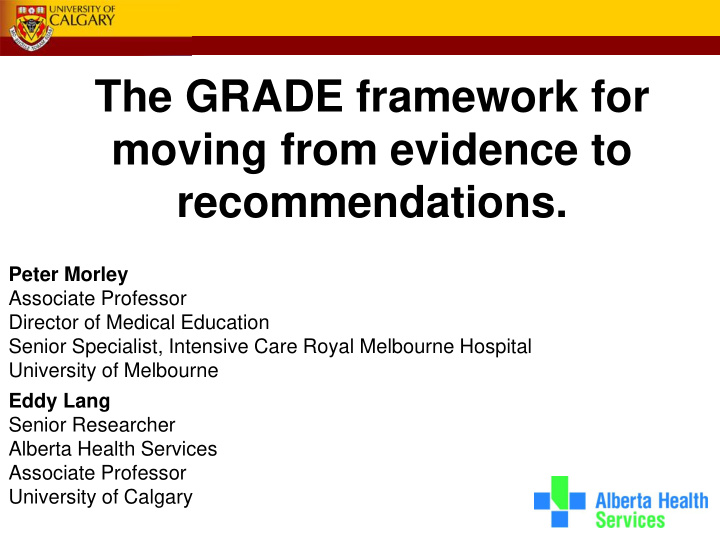



The GRADE framework for moving from evidence to recommendations. Peter Morley Associate Professor Director of Medical Education Senior Specialist, Intensive Care Royal Melbourne Hospital University of Melbourne Eddy Lang Senior Researcher Alberta Health Services Associate Professor University of Calgary
Overview • The GRADE conceptual framework for developing recommendations • Four dimensions • Language consideration
Evidence-based clinical decisions Patient values and Clinical preferences circumstances Expertise Research evidence 3 Haynes et al. 2002
GRADE: Making recommendations Factors to consider Quality of the evidence Balance between benefits and harms Patient values and preferences Resource use (cost, human resources, etc.) Strength of recommendation Wording Strong recommendation for We recommend... Strong recommendation against We recommend not... Weak/conditional recommendation for We suggest... Weak/conditional recommendation against We suggest not....
Quality of evidence
Balance of benefits versus harms and burdens
Weak or conditional recommendation Conditional Against Strong For
Strong recommendation Conditional Against Strong For
Weak or conditional recommendation Conditional Against Strong For
Strong recommendation Conditional For Against Strong
Values and preferences • What is the evidence?
Resource Implications • What is the evidence?
Other factors in decision making Four Factors Strength of Quality of the evidence recommendati on Balance between desirable and undesirable effects STRONG Values and preferences WEAK/ Resource Use CONDITIONAL
• Inconsistency across/within • 31.6% did not make recommendations clearly – Most of them not written as executable actions • 52.7% did not indicate strength 15
Action oriented recommendations Wording 1 Wording 2 Wording 3 We recommend… Strong We Clinicians recommend… should… recommendation FOR Weak We suggest Clinicians We conditionally might… recommend… recommendation FOR We Clinicians might We conditionally Weak not… suggest...not recommend...not recommendation AGAINST We recommend …not Strong We Clinicians should not… recommend recommendation [weak/strong] recommendation, [MODERATE] …not AGAINST evidence
Implications of a strong recommendation • Policy makers: The recommendation can be adapted as a policy in most situations • Patients: Most people in this situation would want the recommended course of action and only a small proportion would not • Clinicians: Most patients should receive the recommended course of action
Implications of a conditional/weak recommendation • Policy makers: There is a need for substantial debate and involvement of stakeholders • Patients: The majority of people in this situation would want the recommended course of action, but many would not • Clinicians: Be more prepared to help patients to make a decision that is consistent with their own values/decision aids and shared decision making
Conclusions • Recommendations guided by but not locked to Q of E • Other consideration can be enlisted • Promotes transparency • Addresses resource s / costs without formal economic analysis • Recommendations none the less but few strong
Thank You
Recommend
More recommend